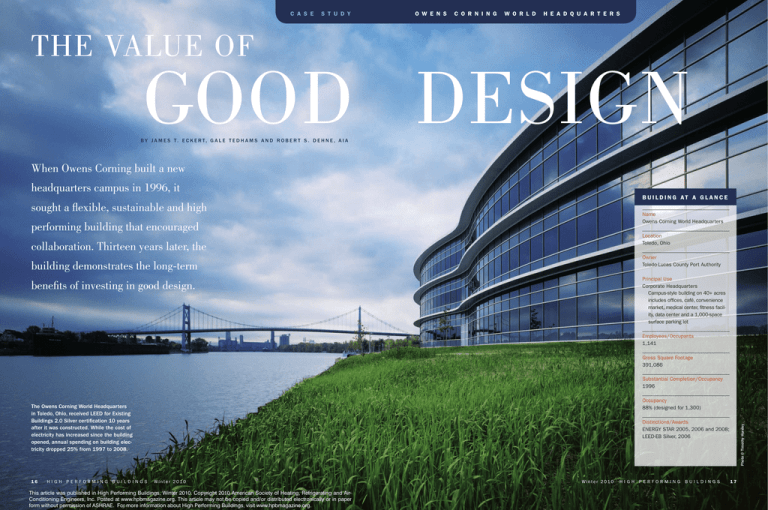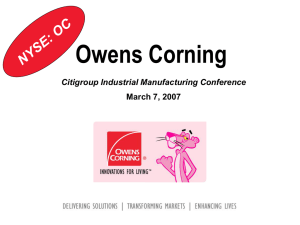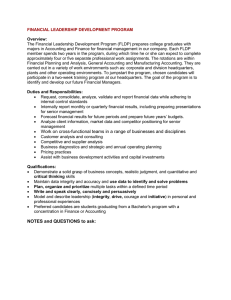Owens Corning World Headquarters: Toledo, OH
advertisement

C A S E S T U D Y O W E N S C O R N I N G W O R L D H E A D Q U A R T E R S THE VALUE OF GOOD DESIGN B Y J A M E S T. E C K E R T, G A L E T E D H A M S A N D R O B E R T S . D E H N E , A I A When Owens Corning built a new headquarters campus in 1996, it B U I L D I N G AT A G L A N C E sought a flexible, sustainable and high Name Owens Corning World Headquarters performing building that encouraged Location Toledo, Ohio collaboration. Thirteen years later, the Owner Toledo-Lucas County Port Authority building demonstrates the long-term Principal Use Corporate Headquarters Campus-style building on 40+ acres includes offices, café, convenience market, medical center, fitness facil- ity, data center and a 1,000-space surface parking lot benefits of investing in good design. Employees/Occupants 1,141 Gross Square Footage 391,086 Substantial Completion/Occupancy 1996 Occupancy 88% (designed for 1,300) The Owens Corning World Headquarters in Toledo, Ohio, received LEED for Existing Buildings 2.0 Silver certification 10 years after it was constructed. While the cost of electricity has increased since the building opened, annual spending on building electricity dropped 25% from 1997 to 2008. 16 HIGH P E R F O R M I N G B U I L D I N G S Winter 2010 This article was published in High Performing Buildings, Winter 2010. Copyright 2010 American Society of Heating, Refrigerating and AirConditioning Engineers, Inc. Posted at www.hpbmagazine.org. This article may not be copied and/or distributed electronically or in paper form without permission of ASHRAE. For more information about High Performing Buildings, visit www.hpbmagazine.org. Winter 2010 H I G H PERFORMING BUILDINGS Photo © Timothy Hursley Distinctions/Awards ENERGY STAR 2005, 2006 and 2008; LEED-EB Silver, 2006 17 T he headquarters, home to more than 1,100 employees, received LEED for Existing Buildings 2.0 Silver certification 10 years after its opening in 2006. Data show continued performance improvement as the operations team drives for greater efficiency and reduced cost. Two examples of these operational efficiencies are electricity expenses and the cost to move employees. While the average cost of electricity has increased about 6% since the first full year of building BUILDING TEAM Building Owner/Representative Owens Corning (Toledo-Lucas County Port Authority is owner) Architect Cesar Pelli & Associates Development Manager Hines General Contractor The Lathrop Company, a subsidiary of Turner Construction Mechanical, Electrical Engineer Cosentini Associates Consulting Engineers Energy Modeler Cosentini Associates Consulting Engineers Structural Engineer CBM Engineers Environmental Consultant Horizon Environmental: Allan Riley Landscape Architect Balmori & Associates Lighting Design Cosentini Associates Consulting Engineers LEED Consultant Johnson Controls 18 HIGH Photo © Timothy Hursley Civil Engineer AVCA Corporation Top Spaces such as this atrium provide informal meeting areas and encourage conversation. P E R F O R M I N G B U I L D I N G S Winter 2010 Bottom Glass-enclosed staircases that extend into the courtyard give occupants the sense of being outdoors. Employees sometimes go out of their way to use these staircases instead of the elevators or interior stairwells. HPB.hotims.com/28683-16 K E Y S U S TA I N A B L E F E AT U R E S Energy Use Intensity (Site) 58.9 kBtu/ft2 Natural Gas 3.3 kBtu/ft2 Water Conservation Rain gauge incorporated in irrigation system. Site is mostly prairie/natural habitat, which is not irrigated and is mowed only once per year. Low-flow fixtures (sinks, toilets and urinals) are used in the restrooms. Efficient Movement Owens Corning consistently achieves a move rate at its headquarters above 100%. Use of modular desks and moveable-wall partition conference rooms allows fast and low-cost reconfiguration with zero waste. • Landscaping softens the environment and, in conjunction with the glass curtain wall, brings a sense of outdoors to the interior; and Recycled Materials Recycling stations in café, all kitchenettes and conference services area. All desks have paper recycling bins. Lucas County recycles cardboard, aluminum, plastic and glass. All paper goes to a document destruction processing facility and is recycled after destruction. Optimized Operating Systems Building systems (HVAC and lighting) are automated through a building management system to maximize operating efficiency. Operating practices now take into account factors such as when to operate and not operate the HVAC system, how to warm or cool the building after weekends, what temperature to maintain during business hours and what setbacks to use during nonbusiness hours. Quality of Work The building also incorporates many features that enhance productivity. These include: Annual Energy Cost Index (ECI) $1.73/ft2 · yr (gross) • Flexible power and telecommunications systems with wireless access throughout the facility; ENERGY STAR Rating 93 (as of 8/09) Daylighting Café lights, all exterior lighting and atrium sconce lighting are on photosensors. Building was designed to maximize daylighting through its shape and through its lack of floor-to-ceiling walls. Curtain walls consist of 65% glazing. Some windows also have frit pattern to minimize heat gain. Underfloor Air Delivery Air can be delivered at much lower velocities than traditional HVAC systems, resulting in the use of smaller, more efficient fans. The system provides for reconfiguration of the space without the need to rework ducting or make other changes in HVAC. Individual Controls Underfloor air distribution gives employees the flexibility to control airflow and temperature at individual workstations. Site Selection Located on urban land that was once described as a derelict industrial site. More than 55% of the 40 acre site was restored to a natural environment with plantings of native vegetation that support wildlife and are low maintenance. operation (according to the U.S. Department of Energy), annual spending for electricity has dropped 25% from more than $1.05 million in 1997 to less than $790,000 in 2008. The savings have stemmed from reductions in consumption and beneficial sourcing agreements. 20 E N E R G Y AT A G L A N C E * HIGH Quality of Life The building also includes a variety of features and services intended to support healthy living and help occupants balance their work and life needs. These amenities include: • The Courtyard Café with healthy menu options and a high glass wall to let in sunlight and allow unobstructed views of the gardens; • A convenience market that includes laundry, dry cleaning and tailoring services; • A medical center and indoor fitness facility for wellness and physical conditioning; • Indoor and outdoor fitness facilities and walking trails; • Embedded cast and fused panels by noted glass artist Tom Patti. Annual Source Energy 185.6 kBtu/ft2 *Excludes data center energy use. • Use of generous stairwells, central atrium and café to invite casual communication; BUILDING ENVELOPE • Positioning executive offices in the middle of the building for easy access and visibility; Roof Type EPDM membrane and dual layer of 2 in. FOAMULAR 400 insulation; covered with light colored rounded water-worn gravel • Positioning of boardroom for visibility and so that it can be more broadly used; • Ability to broadcast and connect multiple facilities and network meetings; Overall R-value 22.5 • Open environments to encourage collaboration; Reflectivity 0.34 • Avoiding physical barriers in the interior plan so organizations can freely expand and contract as necessary; Walls Type Curtain wall (glazing), brick Overall R-value 12.51 (brick: 0.44, air infiltration barrier: 0.68, insulation: 11, drywall: 0.45) • Use of sound masking (white noise) to reduce distraction from other noise in the environment; and Glazing percentage 65% • Depending on the space’s purpose, using ceiling panels that promote sound absorption or transmission. Foundation Slab edge insulation R-value R-16 (4 in. Thermafiber insulation) • A credit union and ATM; Under slab insulation R-value R-10 (2 in. FOAMULAR 250) • The discovery center for career development; The average cost for moving offices dropped more than 90% from about $1,000 per employee in the more typical previous building to less than $100 today. Modular desks, movable wall partitions and a raised floor system allow for reconfigurations without construction costs. P E R F O R M I N G B U I L D I N G S Winter 2010 Electricity 55.6 kBtu/ft2 Windows U-value 0.29 in winter, 0.28 in summer Driving Forces Organizational objectives, company experience and industry expertise have shaped long-term performance, beginning in the design and construction phases and continuing today. A desire to break down perceived “silos” influenced the headquarters’ Solar Heat Gain Coefficient (SHGC) 0.37 Visual Transmittance 70% Location Latitude 41° 40' N Orientation North to South design. At the previous facility, the 10 business units tended to work as autonomous units. The objective involved flattening the organizational structure and bringing people together for more cross talk and sharing of best practices. Owens Corning is a growing, changing organization, requiring employee and business adjacencies to continually shift. The planning team adopted an interior scheme that was flexible, allowing moves and organizational shifts to take place quickly, with minimal cost, and without generating building materials waste. Industry expertise was gathered by benchmarking recommended best-in-class buildings. The team found little to emulate until it connected with the Advanced Building Systems Integration Consortium (ABSIC), a coalition at CarnegieMellon University. The ideas and concepts gathered from ABSIC are reflected in some of the best features of the building. Winter 2010 H I G H The red tower above the lobby of the Owens Corning World Headquarters echoes the curving line in the company’s logo. Sunlight streams though the porthole windows, moving through the space as the sun tracks across the sky. Ventilation and Daylight Two examples of those best features are the raised floor/underfloor ventilation system and daylighting afforded by the narrow floor plate. Underfloor ventilation provides operating and energy efficiency as well as environmental advantages. Conditioned air is delivered through the raised flooring system at a lower velocity than traditional HVAC systems and passes by the occupants on the way to being returned at the ceiling. Natural convection of the conditioned air allows it to move more efficiently, resulting in the use of smaller fans, which means less energy consumption. Controllable vents can be relocated easily or added anywhere in the work space to optimize occupant control, comfort and air quality. PERFORMING BUILDINGS 21 BUILDING ENERGY USE Electricity (kWh) Natural Gas (cubic feet) 2007 2008 2009 2007 2008 2009 Jan 638,526 756,472 780,921 190,100 77,500 96,700 Feb 1,034,471 808,031 812,844 184,000 104,000 106,200 Mar 786,701 675,990 613,130 45,200 131,900 114,900 Apr 619,881 534,623 436,206 117,800 104,600 102,100 103,000 May 468,051 440,234 314,350 96,600 113,400 Jun 531,554 509,579 365,619 101,500 104,000 99,800 Jul 618,806 575,526 491,454 110,200 99,000 87,500 Aug 630,971 633,791 468,631 104,000 110,000 98,300 Sep 561,171 569,332 447,049 99,200 90,600 95,700 Oct 522,977 436,000 107,000 104,000 Nov 464,679 435,211 131,800 112,200 Dec 696,345 685,177 142,500 128,600 Annual 7,574,133 7,059,966 Underfloor air distribution gives employees the flexibility to control airflow and temperature at their workstations. Air can be delivered at lower velocities than traditional HVAC systems, resulting in the use of smaller, more efficient fans. A further enhancement to operational and energy efficiency as well as occupant comfort is the daylight and views to the outdoors created by a relatively narrow floor plate in combination with ample glass. Offices and work areas are near but not next to windows, so interior walls do not block incoming light. The design reduces the need for artificial light while creating a pleasant environment for employees. 1,429,900 1,279,800 Excludes data center energy use. Flexible Space Photo © Timothy Hursley The raised floor system also accommodates modular underfloor power and data distribution systems that simplify the reconfiguration of work space. In the previous headquarters building, it cost an average of $1,000 per person to move or realign individuals and business teams. That cost included contractors to rework walls, ceilings, lighting, power, mechanical and supporting services, as well as administrative coordination and move time. 22 HIGH P E R F O R M I N G B U I L D I N G S Winter 2010 The scalloped exterior of the building replicates waves in the adjacent Maumee River. An open floor plan encourages collaboration and maximizes daylighting. HPB.hotims.com/28683-10 Since all partitions, office furniture and services within the office areas of the current building are a modular “kit of parts,” and the services are accessible via the raised floor, today moving costs are negligible. The moves can be completed by on-site facilities personnel rather than hired contractors. The goal was to be able to reconfigure the work space with no more than a hammer, wrench and screwdriver. And that’s the final result. The sustainability benefit of this move process is that all components can be reused; no waste is going to a landfill. COMMERCIAL BUILDINGS ENERGY CONSUMPTION S U RV E Y ( C B E C S ) C O M PA R I S O N Site Energy Intensity Source Energy Intensity Owens Corning World HQ* 58.9 kBtu/ft2 185.6 kBtu/ft2 CBECS National Averages 91 kBtu/ft2 190.4 kBtu/ft2 *Averages based on principal building activity. Excludes data center energy use. Data Center Another significant contributor to efficient operation is the HVAC management system. One challenge to effectively managing resource use in this building is the data center servers. The data center used 28% of the total energy in 2008 (up from 22% two years earlier), while occupying less than 1% of the building area. Data centers are large consumers of electricity to operate and cool the servers. When compared to buildings without data centers, our energy use is high. The building nevertheless has an ENERGY STAR rating of 93, placing it in the top 10% of this type and size, because the program allows the energy use of the data center area to be backed out, providing the energy use is metered. Managing energy use in the data center is an important factor in the overall trend to cut energy consumption in the building by more than 25%. More energy-efficient servers have been deployed along with a cooling strategy to focus on the equipment instead of the whole room. This is certainly helping, but gains have been more than offset by growth in data processing and storage capacity. Other contributors to driving down operating costs include leveraging daylighting with additional controls Above Reflective glass on the river side of the building reduces heat gain. Lowmaintenance native grass is mowed once a year and does not require irrigation. The glass wall in the Courtyard Café provides daylighting and views of the gardens. Light sensors control the level of artificial lighting. Left At the company’s previous headquarters building, reconfiguring office space required moving walls, ceilings, and lighting and cost an average of $1,000 to move each employee. The new headquarters’ modular workspaces can be reconfigured with only a hammer, wrench and screwdriver, costing less than $100 per person. and developing an automated stepby-step process for conditioning the building before occupants arrive in the morning. Motion detectors and photocells monitor and turn off lights when they are not needed. The company also launched a program in 2002 to solicit ideas from employees. A team was assembled Top The relatively narrow floor plate of the building provides views of the interior courtyard and Maumee River. Ample glass provides daylighting, reducing the need for artificial light while creating a pleasant environment for employees. Above Small white circles applied to the glass in a frit pattern help reduce heat gain on the courtyard side of the building. 24 HIGH P E R F O R M I N G B U I L D I N G S Winter 2010 Winter 2010 H I G H PERFORMING BUILDINGS 25 to evaluate and prioritize the best suggestions; some demonstrated big savings, were easy to deploy and required no investment, so they were implemented right away. So many ideas were submitted that the facilities team is still working to implement some of them. LEED Certification When seeking LEED certification, the initial examination revealed 23 LEED credits earned or achievable with simple documentation and no cost. With further study, 21 more credits were found to be readily available, again with no cost. The combined savings from all of the credits resulted in operational savings of more than $100,000 per year. Much was learned while preparing to seek LEED certification, including ideas for new control strategies that resulted in reduced energy costs and improved indoor air quality. One significant issue was lighting. For aesthetic reasons, an uncommon lamp was selected in the initial construction for the primary lighting fixture throughout the office areas: a fluorescent T8 U-tube with a smaller-than-usual turn radius. The lamps are energy efficient, but every lamp has mercury in larger amounts than the best-in-class standard. Since there were no alternative U-tube lamps available, the existing lamps are being replaced with alternative straight tube lamps, which have the added benefit of reducing consumption while maintaining sufficient levels of lighting. Value of Efficiency Although the company didn’t invent anything new for the building, the teams brought together an unusual combination of materials, technologies and processes that assist in managing the overall system. The building serves as a symbol of the company’s LESSONS LEARNED Business value in social environment Work space can be arranged to create “casual collisions” that enable interaction and exchange of ideas. Recruiting value in culture of connectivity The physical and cultural environment that job candidates experience when they visit has helped the company hire extraordinary talent. Economic and environmental value in flexible work space Operating sustainably means more than conserving energy; flexible work spaces facilitate reconfigurations without construction costs or waste, keeping $500,000 worth of scrap building materials out of the landfill annually. Willingness to try new approach can pay dividends The decision to use underfloor air distribution was scary at the time, but we have been rewarded with occupant comfort, energy savings and flexibility. Occupant engagement adds value We insisted that the building design team work in our offices to ensure a high level of interaction. A core team of employees was involved in the project as well. We rallied around a shared set of objectives. 26 HIGH For a different result, work differently We forced a coalition among the interior design firm, furniture supplier and the furniture installer to encourage fresh thinking, parallel development and breakout results. Address “whole life” aspects of work We are more productive when we have easy access to basic needs such as fitness, banking, health care, food, laundry and dry cleaning, etc. Buy-in from the top on objectives is critical The CEO was actively engaged and secured alignment within the leadership team around the objectives at a critical time when early decisions were being questioned. Leverage outdoor attributes We created a pleasing and productive environment with daylighting, open sight lines, and exterior and interior landscaping that appears to bring the outside world indoors. You can have it both ways Organizational needs called for a horizontal building in a campus-like setting, which typically means a location in the suburbs. However, we found a way to achieve our business needs in the urban environment. Redefining how work space is allocated and used We converted to a culture of shared space and teaming while preserving individual space and identity. Private space is available and team space is plentiful. Highlight stairwells and common spaces to enhance networking Our stairwells are wide enough for side-by-side conversations to continue during movement between floors. Executive visibility is positive Corporate leaders are in the middle of things with offices in the center of the building. The board room also is centrally located. The facility does not include any designated parking or dining areas for executives or the board. Harnessing community resources The state, county, city and local port authority teamed up to obtain grants and loans, purchase the land and assemble the financing mechanism for our leased facility. P E R F O R M I N G B U I L D I N G S Winter 2010 HPB.hotims.com/28683-13 Learn How to Commission Your High Performing Building! continuing commitment to energy efficiency and leading by example. Good design adds value faster than low cost. If you make a facility comfortable, flexible and energy efficient, you can save money forever. The building also is an example of the good that can result when a project is approached holistically and with sustainability in mind. • RIGHT FROM THE START— Commissioning for High Performing Buildings April 21, 2010 1:00 – 4:00 P.M. EDT FREE Webcast from ASHRAE ABOUT THE AUTHORS James T. Eckert is corporate real estate director at Owens Corning and was project manager for the construction of the building. Gale Tedhams is sustainability director at Owens Corning. Signs posted along a walking trail describe the campus’ various plants. The headquarters also includes a fitness facility and medical center. Robert S. Dehne, AIA, CSI, is architectural manager, Sustainable Communities, at Owens Corning. Hear from leading commissioning experts about how commissioning supports a smoother construction process, maximizes energy and cost reductions, and provides a facility that operates as intended. This program will define the “what, why, when, and who” of the commissioning process and provide you with tools to commission your high performing building. Online registration begins March 2, 2010, at www.ashrae/Cxwebcast.com. There is no fee for registration. For details on the program and presenters, visit www.ashrae/Cxwebcast.com. HPB.hotims.com/28683-8 HPB.hotims.com/28683-50 This free webcast is sponsored by the ASHRAE Chapter Technology Transfer Committee with support from ASHRAE’s High Performing Buildings Magazine. H IGH P ERFORMING B UILDINGS



